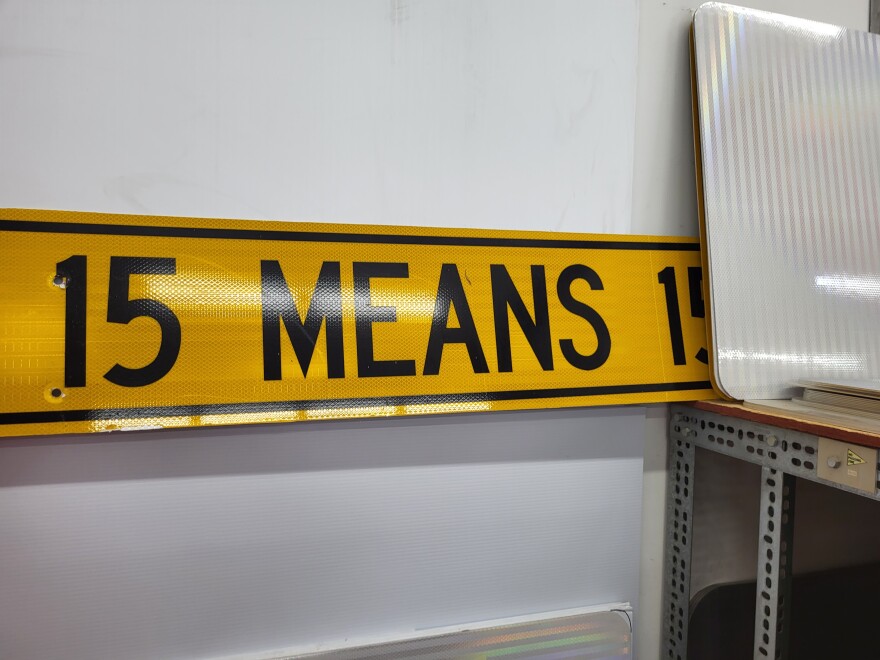It’s about a half hour til quitting time at the Greene County Engineers Office in Xenia and Justin Windsor and his crew have just came back from painting street lines on a blisteringly hot summer day.
Justin Windsor is a foreman with the traffic department where he has worked for the past 16 years. While Windsor showed me around the shop, the remaining crew jump in a truck and leave again to fix a stop sign.

“That’s our striper,” Windsor said, pointing to the huge machine that paints the traffic lines on roads. “We paint 290 miles of county roads and we take care of probably 120 miles of township and city roads”
Windsor said they go through about 9,500 gallons of paint a year and around 80,000 pounds of glass beads that make the paint reflective.
And that’s just the painting side of it,” Windsor said. “Then we take care of 23 traffic signals, 10 flashing lights, 7 sets of school flashing lights, and then we make all the signs for the county; make ‘em, maintain ‘em, and everything. So I think there's over 3,300 signs in the county.”
Windsor turned the light on in the shop where large wooden stencils hung on the wall spelling out "S.C.H.O.O.L."
“That’s actually really old, we don’t use those anymore,” Windsor told me. But he likes to keep some of the cool, older materials that they used to use around.
The traffic department is one of the few local places that still makes its own street signs using a computer program to print out the graphics.
“The basic signs, we have a program for them," Windsor said, showing me the machine used to print out the graphics. “Sometimes we’ll have to design a couple of them here and there.”
Windsor goes through the process of making a new sign, lining the black graphics up on the sign to make a new 25 mile per hour road sign.
"You load up material,” he said, feeding the black vinyl into the machine. “You cover your aluminum with your hp material, which is high performance, or high reflectivity.”
Wooden racks in the shop contained an array of street signs already made up. Windsor pulled out a round yellow sign with a big X through it, flanked by the letters R.
“Bet you haven’t seen these in a long time, these railroad crossing signs,” Windsor said holding the big sign. “We don’t have any railroad crossings left in the county so these are pretty much vintage.”

Windsor laughed as he pulls another sign out of the rack. This one was a long, narrow green sign that said, "15 means 15."
“I don’t know if you’re familiar with Social Row Road,” Windsor said, explaining the sign. “There’s a sharp curve right on Social Row right before Wilmington Dayton. There’s a few accidents that kept happening. We’ve got curve signs, we’ve got chevrons, we’ve got it lit up like a christmas tree at night time, and people still kept getting in accidents. So our old engineer, Bob Geyer, on a whim one day, said to put a sign under the curve sign that says '15 means 15.' It caught people's eyes and it worked.”
When asked if there is a particular street sign that gets stolen often, Windsor said that street signs with more unusual names are usually a target and that there was one particular sign out by Jamestown that became a favorite with vandals.
“I forget the exact road name they kept taking, but they were taking that sign almost every week,” Windsor said, reflecting back. “So we used to have some lithium grease back here, which is clear. We’d put the lithium grease on top of the road name so when someone went to steal it their hands are in the grease, and it wasn’t taken anymore.”

Windsor added that “you’ve got to be creative sometimes. You don’t want to get anybody hurt, but you just want to maybe dirty their hands a little bit, make them earn it.”
Windsor said that he and his crew are on call 24/7 which can make celebrating holidays tricky for him and his crew.
“We’ve been called in 25 times this year for various things,” Windsor said. “Accidents, trees across a road, to close a road. Stop signs down. When a stop sign gets hit we have to come in and fix it in a timely manner. Kind of puts a damper on your holidays every now and again.”
Windsor said that his favorite part of the job is the diversity of the day to day work.
“There is always a challenge, something always pops up,” he said. “It’s just cool knowing that you can drive down the road and say, hey, I did that. I took care of that.”


